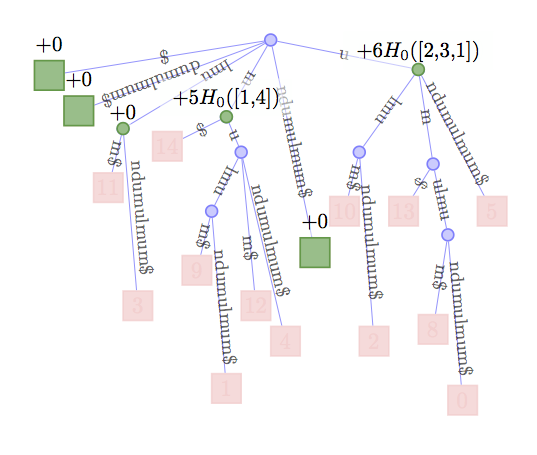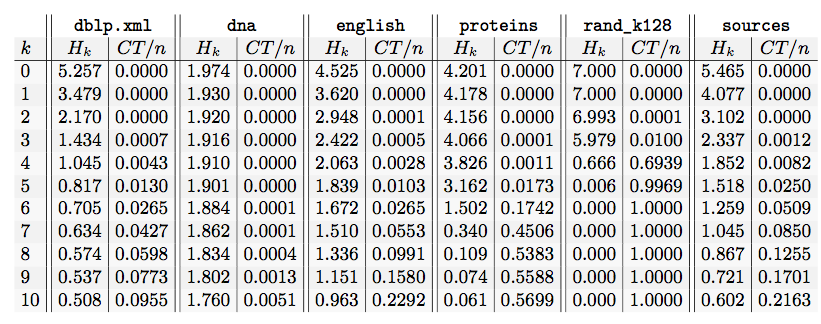Calculating the k-th order empirical entropy in linear time
In this post, I will explain how it is possible to efficiently
calculate different measures of text compressibility -- the zeroth
and \(k\)-th order empirical entropy -- using
sdsl. For both cases
we use a compressed suffix tree (CST) to do the calculation.
So step one is to build a compressed suffix tree of a
text file. This can be easily done with the following
code snippet:
You can copy this program into the examples directory and
execute make to get an executable, which will
construct a CST for the file given by the first argument
to the program. Lets take for example the file
faust.txt which is located in the libraries
test suite. A run of the program produces a CST
names faust.txt.cst3. The CST has size
460 kB for the original 222 kB.
1 Calculating the zeroth order entropy
The zeroth order empirical entropy \(H_0\) of a text \(\TEXT\) of length \(n\) over an alphabet \(\Sigma=\{c_0,\ldots,c_{\sigma-1}\}\) of size \(\sigma \) is a lower bound for a compressor which encodes each symbol independently of any of its preceding or following symbols.
where \(n_i\) is the number of occurrences of character
\(c_i\) in \(\TEXT\). It is very easy to see that
\(n_i\) corresponds to the size of subtree (e.g. number of
leaves in the subtree) rooted at the
\(i\)-th child of the root of the CST. The length of the
text \(n\) corresponds to the size of the whole tree.
Therefore, the following method calculates \(H_0(\TEXT)\)
if v is the root node of our CST:
The code is straightforward: If the root node is a leaf, then
the tree and the text are empty and \(H_0\) should be 0.
Otherwise we recover \(n\) by determine the size of the
subtree of v and calculate the first child. We then add for
each child its weighted contribution to \(H_0\). Note:
cst.sibiling(w) returns the root node cst.root() if there
is no next sibling.
2 Calculating the k-th order entropy
Example
Lets look at an example. Say our string is \(\TEXT\)=umulmundumulmu$
and we and to calculate \(H_1(\TEXT)\).
Then the occurrences of substrings d, l, and n are always followed
by the same character and so they do not contribute to the result.
Have a look at the figure below to also note that all these substrings
are not represented by a node in the CST. $ is represented by
a node but does also not contribute since it is a leaf node and
therefore \(T_{\$}\) empty. We can also determine from the figure
that the substring m is followed by one $ and four u and
therefore adds \(5H_0(T_m)\) to the result. Note that the
actual order of characters in \(T_m\) does not change
the result and it is enough to know the distribution of
symbols. In our case \([1,4]\). Finally, we do the
same procedure also for substring u.

Experiment
Lets take the 200 MiB test cases of the Pizza&Chili corpus build the CST with the program above and calculate \(H_0,\ldots,H_{10} \) with this program:
Voilá, here is the result:

In one of the next posts, I will show that we can reach about \(H_4\) in practice. If we choose larger values for \(k\) then the number of contexts \(CT\) is so high, that the information which is needed to store context information dominates the space.
References
- Manzini's SODA article and
- the full-text index overview article of Navarro and Mäkinen.
- The figure and algorithms were also used as an example in my thesis.
blog comments powered by Disqus